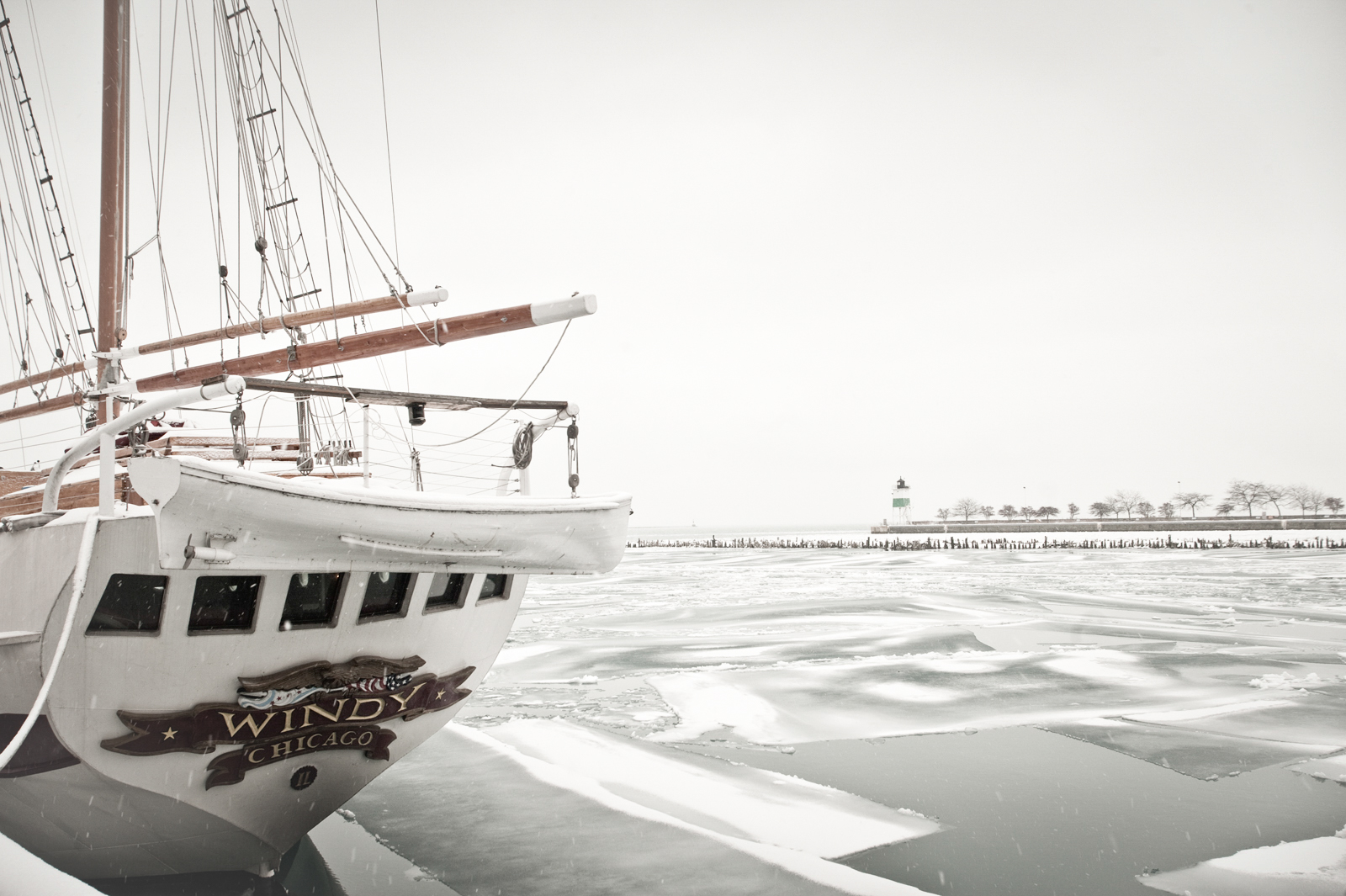Have you ever noticed how much you remember about a photo you took so long ago? Ever wonder why?
Let’s start with a little exercise: Choose one photo from a trip or outing taken a year or longer ago and ask yourself
- Where was I?
- What stopped me to take this photo?
- Who was I with, if anyone?
- What was going on before I clicked the shutter?
- What time of day was it?
- What was the weather like?
- What did it take for me to get this photo?
My Photo’s Story
This photo was taken right about midnight on the night after the Chicago Blizzard on Groundhog Day, February 2, 2011. I bundled up, added snow pants and YakTrax grip pers to my winter boots and headed out to the Lakefront taking the only bus in my neighborhood operating on the only street that was semi-clear. I had to walk a distance from the bus stop to the museum and lake area. While there were footprints all over the snow from people exploring the winter wonder during the day, there wasn’t a person in sight where I was for those few hours. After capturing scenes of snow plow trucks transferring the mounds of snow from a closed and abandoned Lake Shore Drive, I arrived at this scene: nothing but black, white and water. The only sound to be heard was an occasional swooshing of the square chunks of snow that covered the lake water bumping into each other as the water underneath moved. It was the epitomy of “Creepy”, add to this the fear of water I had earlier in life bringing an uneasy feeling to my stomach. I was determined to capture the ominousness of this scene so I set my tripod up as close to the edge as possible, set my camera settings, clicked “mirror lock-up” (a 30-second delay often used in lieu of a remote shutter release) and hit the shutter. I then stepped back and turned away (though I’m not sure what I thought I was afraid to look at), hopping up and down to warm my body. I repeated these actions a few times until I had the photo I wanted. Satisfied, I moved on to “safer” ground and continued capturing other snowy scenes, but none resonated with me like this photo.
pers to my winter boots and headed out to the Lakefront taking the only bus in my neighborhood operating on the only street that was semi-clear. I had to walk a distance from the bus stop to the museum and lake area. While there were footprints all over the snow from people exploring the winter wonder during the day, there wasn’t a person in sight where I was for those few hours. After capturing scenes of snow plow trucks transferring the mounds of snow from a closed and abandoned Lake Shore Drive, I arrived at this scene: nothing but black, white and water. The only sound to be heard was an occasional swooshing of the square chunks of snow that covered the lake water bumping into each other as the water underneath moved. It was the epitomy of “Creepy”, add to this the fear of water I had earlier in life bringing an uneasy feeling to my stomach. I was determined to capture the ominousness of this scene so I set my tripod up as close to the edge as possible, set my camera settings, clicked “mirror lock-up” (a 30-second delay often used in lieu of a remote shutter release) and hit the shutter. I then stepped back and turned away (though I’m not sure what I thought I was afraid to look at), hopping up and down to warm my body. I repeated these actions a few times until I had the photo I wanted. Satisfied, I moved on to “safer” ground and continued capturing other snowy scenes, but none resonated with me like this photo.
In case you’re wondering, this is not a color photo turned black & white.
Photography is so much more than just creating or documenting a moment in time. It brings you into the present, evokes emotion, triggers multiple senses, challenges your mind, exercises your vision and often provides a physical workout.
Brings You Into Present
When you’re honed in on a subject, thinking through composition, settings, light, etc, are you simultaneously thinking about the past? The bill that needs paid? What you’re going to do for dinner? The presentation you have to finish or just gave? Worrying about your child’s college education? More than likely, no. You’re mind has set all of that aside to be fully engaged in this moment you’re creating in your camera.
This is the main reason photography (as with music or dance) can improve your mood. Unsure what I mean? I challenge you to test this yourself with intention. Schedule an hour this week to take photos, indoors or outdoors, with whatever camera you have – it’s the act, not the tool. Before you begin, take notice of your mental, emotional and physical state. When the hour is up, take notice once more. Do you notice the change?
Evokes Emotion
Okay, so you may not be laughing or crying from taking photos, but consider how you feel when watching your subject. If it’s a person, is what they’re doing making you react emotionally? If a building or landscape, are you appreciating its beauty (or lack of)? Do you feel grateful that you noticed it when others may not?
And what about when you’ve taken ten photos of the scene and it’s that one that makes you grin and think “I got it”. Satisfaction. Accomplishment.
Photography is as much as your emotion as about evoking emotion in your viewer.
Triggers Multiple Senses
Senses trigger chemical reactions in your brain and play an integral role in creating memories which is why they’re an important part of your photos. “You can’t see senses in photos”, you argue. Well, no, but everything around you impacted the photo you took whether you noticed or not.
Are you exploring an urban environment, like I do, hearing the hustle & bustle of people and transportation? You smell, good or bad, the “urban smells” (or, in a section of Chicago, chocolate). Touch the water or textures on a building. Whether you’re consciously aware of it or not, these things are stamping a day, time, sense of place and a story on your photos. Food photography, industrial, commercial, rural…they all have sights, smells, sounds.
On your next outing, try to be more aware of what’s triggering certain senses and let them guide your photo more.
Challenges Your Mind
Remember I said photography brings you into the present. Now that you’re here, how is photography challenging your mind?
- Composition: Whether adhering to the “rules of photography” or your goal is more artistic, you have control in composing the photo the way you want your viewer to see
it. Do you want to use or break the rules? - Technical: Whether you’re making calculations or have memorized and practiced, you’ve got to find the right combination of settings on your camera to produce the desired results
- Memories: Is your goal to tell a story? There may be history or information about your subject that will influence the way you pose or compose the subject to tell the story
- Strategy: Are you thinking ahead, anticipating the scene?
- Mind-to-hand coordination: If you’re shooting sports, your children, your dog, the reaction time between your brain, eyes and hands can be the difference between capturing the action or not.
Photography keeps the mind active, both technically and creatively, and keeping your mind active and sharp helps in other areas of your life.
Exercises Vision
This is one we often take for granted. When was your last eye exam? That long ago?! *sigh*
Photography requires both distance and near vision, and by switching back and forth, you’re exercising your eyes.
It might be safe to say photography is good for your vision 😉 at least much healthier than staring at the computer screen all day.
Provides A Physical Workout
Often, we’re nursing our aches and pains from photography and don’t realize it’s a very physical activity. This is especially true for outdoor, event and wedding photography, but even if you do studio work, you’re getting a workout. Walking, bending, climbing stairs or a ladder, carrying equipment, raising and lowering the camera (is your bicep on your camera-carrying arm larger than the other?).
Example: When I give a 5-hour tour, I average 16,000 steps while schlepping 20-40 pounds of gear
It’s that last part that we need to be most aware and take proper care of our camera-carrying bodies. Bags and backpacks of gear can strain the back, hips, feet, neck and shoulders. Hip strain is especially troublesome for photographers as it radiates to cause knee pain.
Before and after you go out, remember to do some basic stretches, wear good, supportive shoes for the environment and amount of time you’ll be shooting. And drink water! Keeping hydrated helps the muscles stay lubricated and avoid stiffening up.
With every part of your body, mind and soul being involved in your photo, is it any wonder we remember the story around the click?
See What’s Coming Up with our affiliate sponsor, CreativeLive
(Disclosure: As an affiliate marketing partner, CreativeLive will compensate me for purchases made with my affiliate link above.)

